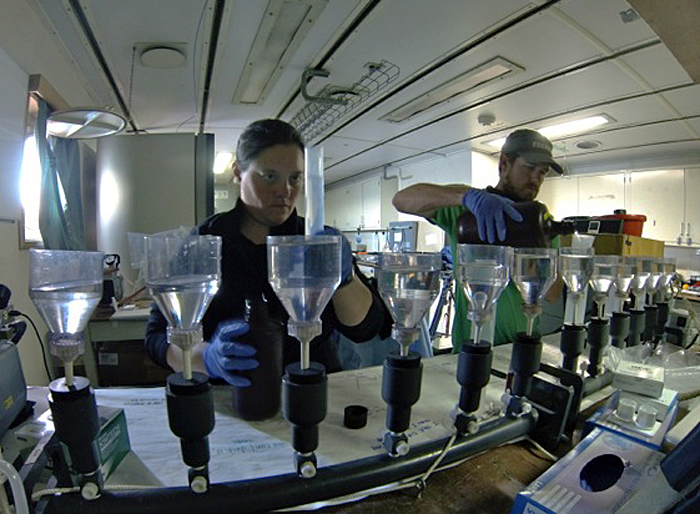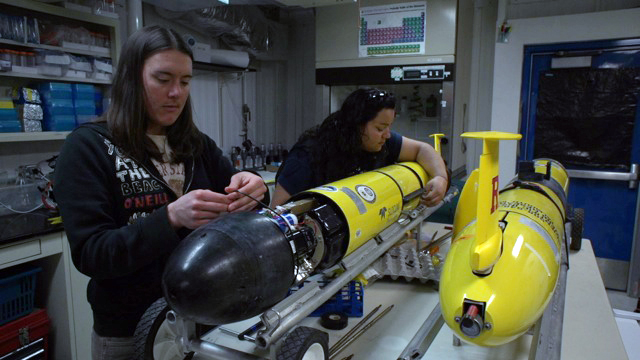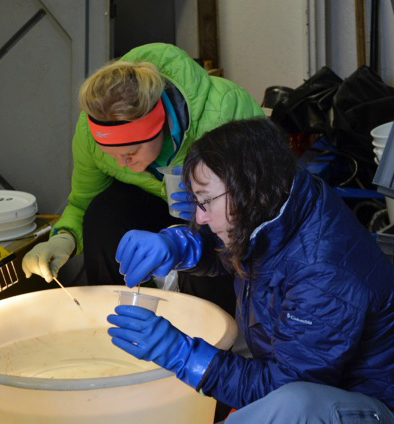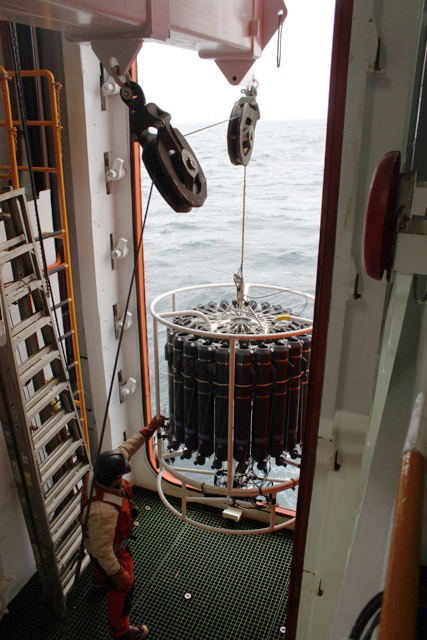|
Never a dull momentPalmer LTER scientists still encounter surprises after 22 years of observationsPosted April 4, 2014
Even after more than two decades of monitoring one of the fastest changing regions on the planet, researchers with the Palmer Long Term Ecological Research (LTER) Ironically, one of those surprises involved the presence of sea ice across the western side of the Antarctic Peninsula, a region experiencing some of the most dramatic climate changes on the planet. “Nowadays, we have to go out of our way to encounter sea ice, but this year was amazing. We ran into ice throughout the study area. It forced us to be creative when we couldn’t go where we wanted to,” said Hugh Ducklow Despite the heavy, persistent sea ice this year, researchers continued to examine an ecosystem in transition, in which ecological community structure and biogeochemical cycles have been altered by climate change. For the last 22 years, a team of scientists and students have embarked on an oceanographic cruise each January to examine long-term spatial and temporal changes within a large swath of ocean. The sampling grid extends 700 kilometers south from Palmer Station down to Charcot Island and 200 kilometers offshore to the continental shelf break. [See previous article — Back in time: Palmer LTER scientists monitor climate change across Antarctic Peninsula.] Meanwhile, a team also works out of Palmer Station Fieldwork during the cruise usually coincides with peak biological activity in the austral summer and the annual low point in sea ice cover. However, this year many areas were iced in, delaying local sampling at Palmer Station and slowing the research vessel Laurence M. Gould Research cruises include a full suite of standard hydrographic stations and sampling procedures aboard the Gould. Conductivity-temperature-depth (CTD) casts from the ship are complemented by spatial surveys from the Slocum robotic glider In particular, the gliders and ocean moorings help LTER scientists combine high-resolution data with traditional shipboard results in an effort to gain better insights into regional ecology and biogeochemical cycling, ocean physics and circulation. Since 2009, the gliders have logged 41 missions, representing 468 days at sea and more than 8,000 kilometers flown underwater. Since 2007, the LTER has also collected more than 25 mooring-years of physical data, with samples recorded every minute. Together these datasets likely make the LTER area the most densely sampled region in the entire Southern Ocean. Blooming studiesDuring the 2014 research cruise, covering an area of 140,000 square kilometers, LTER scientists encountered one of the largest blooms of phytoplankton Chlorophyll concentrations (an indicator of phytoplankton abundance) exceeded 25 milligrams per liter (mg/L), a level typical of enriched estuaries like Chesapeake Bay. A big bloom doesn’t necessarily mean more krill and penguins, however; preliminary indications suggest that the bloom was not dominated by diatoms, the preferred food for krill, which are the primary prey for Adélie penguins. 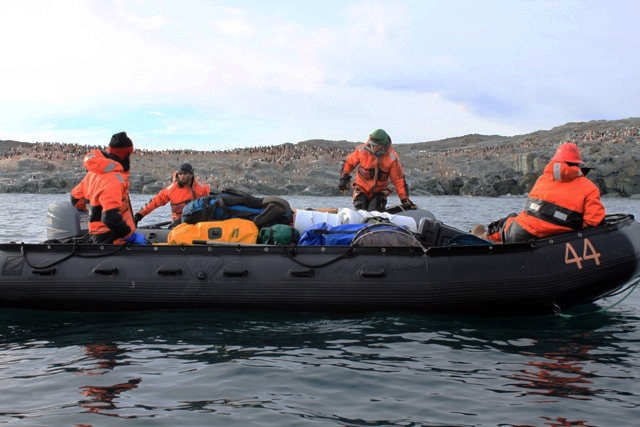
Photo Credit: Beth Simmons/PAL Education & Outreach
Scientists approach Avian Island, home to more than 200,000 Adélie penguins.
At this point, it actually looks like the bloom was mainly feeding bacteria not krill. “Bacteria in these areas were in hot pursuit of the carbon fixed in the blooms, yielding some of the highest bacterial growth rates our group has ever measured,” Ducklow noted. “The very late sea ice retreat likely triggered this humongous bloom. Our job now is to figure out how,” noted Oscar Schofield To understand the implications of the phytoplankton bloom, and place it in context of their time series from previous observations, LTER scientists also conducted a series of net tows to characterize the zooplankton community – small marine organisms like shrimplike krill and gelatinous salps – that graze on phytoplankton. Besides feeding penguins and whales, zooplankton also excrete nutrients and dissolved organic carbon that fuel microbial activity. Additional experiments evaluated rates of fecal pellet production and excretion, two processes by which food consumed by zooplankton can be funneled to the microbial community and into the ocean’s carbon cycle. LTER scientists hypothesize that as the zooplankton community composition changes in response to sea ice loss, the biogeochemical cycles that they help to catalyze will also be altered, with poorly understood effects. To improve their understanding of ecosystem changes, Palmer LTER researchers are also developing a working model of the ecosystem to identify links and mechanisms controlling many of these processes. Preliminary results from the model suggest that in the northern region of the western Antarctic Peninsula closest to Palmer Station, the food web is shrinking in terms of the size of the principal organisms. It appears the ecosystem is no longer dominated by larger phytoplankton, zooplankton and large, top predators. Instead, there is a transition toward a more microbial food web dominated by small phytoplankton and single-celled organisms. A principal aim of the modeling exercise is to suggest how these food-web changes might affect the large, native polar predators at the top of the food chain, including crabeater seals (Lobodon carcinophagus), Adélie penguins (Pygoscelis adeliae) andhumpback whales (Megaotera novaengliae), which have become a new addition to the LTER program. Visual surveys conducted during the cruise assessed abundance and distribution of penguins and whales within the Palmer LTER regional study area. LTER scientists camped out on Avian Island, 400 kilometers south of Palmer Station for five days, studying Adélie penguin foraging, chick rearing and diet composition. The new whale team took biopsy samples by approaching diving whales in Zodiacs. The 2013-14 field season exemplifies an important, but poorly understood aspect of long term research: What are the consequences of extreme events like the heavy sea ice and vast phytoplankton bloom the scientists encountered this year? “These events could ripple through the system for decades,” Schofield mused. NSF-funded research in this article: Hugh Ducklow, Columbia University, Award No. 1344502 |



For USAP Participants |
For The Public |
For Researchers and EducatorsContact UsU.S. National Science FoundationOffice of Polar Programs Geosciences Directorate 2415 Eisenhower Avenue, Suite W7100 Alexandria, VA 22314 Sign up for the NSF Office of Polar Programs newsletter and events. Feedback Form |

